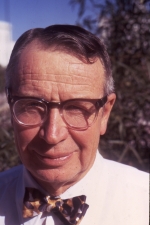Henry L. Giclas facts for kids
Quick facts for kids
Henry Lee Giclas
|
|
|---|---|
 |
|
| Born | December 9, 1910 |
| Died | April 2, 2007 (aged 96) |
| Occupation | Astronomer |
| 1886 Lowell | June 21, 1949 |
| 2061 Anza | October 22, 1960 |
| 2118 Flagstaff | August 5, 1978 |
| 2201 Oljato | December 12, 1947 |
| 2313 Aruna | October 15, 1976 |
| 2347 Vinata | October 7, 1936 |
| 2415 Ganesa | October 28, 1978 |
| 3110 Wagman | September 28, 1975 |
| 3177 Chillicothe | January 8, 1934 |
| 3382 Cassidy | September 7, 1948 |
| 3487 Edgeworth | October 28, 1978 |
| 3695 Fiala | October 21, 1973 |
| 6277 Siok | August 24, 1949 |
| (7731) 1978 UV | October 28, 1978 |
| (10451) 1975 SE | September 28, 1975 |
| (15204) 1978 UG | October 28, 1978 |
| (17353) 1975 TE | October 10, 1975 |
| co-discovered with Robert D. Schaldach | |
|---|---|
Henry Lee Giclas was an American astronomer. He was born in Flagstaff, Arizona, on December 9, 1910. He spent his life studying space and discovering new objects. He passed away in Flagstaff on April 2, 2007, at 96 years old.
Contents
Discovering Space Objects
Henry Giclas was famous for finding many objects in our solar system. He discovered 17 minor planets, which are like small rocky bodies orbiting the Sun. He also found a comet!
Working at Lowell Observatory
Henry Giclas worked at the Lowell Observatory in Flagstaff, Arizona. This is a famous place where astronomers study the sky. He used a special tool called a blink comparator. This tool helped him compare old and new photos of the sky. By doing this, he could spot objects that had moved. This is how he found many asteroids and even a comet.
He also worked on a project to measure how stars move across the sky. This is called a "proper motion" survey. Some stars are even named after him, like Giclas 99-49, because of his work.
His Amazing Discoveries
The Minor Planet Center officially credits Henry Giclas with finding 17 minor planets. These are small objects that orbit the Sun, usually between Mars and Jupiter. Some of his notable discoveries include 2201 Oljato and 2061 Anza.
- 2201 Oljato might be the source of a meteor shower called the "Chi Orionids."
- 2061 Anza is a near-Earth asteroid. This means its orbit brings it close to Earth.
In 1978, Henry Giclas also discovered a comet named 84P/Giclas. This comet is part of the "Jupiter family." These comets have orbits that are influenced by the giant planet Jupiter.
Things Named After Him
Henry Giclas made important contributions to astronomy. Because of his work, a crater on the dwarf planet Pluto is named Giclas. Also, an asteroid called 1741 Giclas is named in his honor. This asteroid was discovered by the Indiana Asteroid Program in 1960.
See also
 In Spanish: Henry Lee Giclas para niños
In Spanish: Henry Lee Giclas para niños

